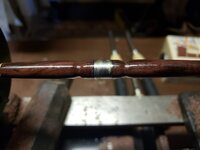Taylorrock99
Member
Picture not all that great, but I seem to have little streaks left behind. I did 4 layers of thin CA. With somewhere around 4 to 5 drops or so Each time, rubbing 2-3 seconds with papertowl. Then i wet micro meshed up to 12000 but are still there. Am I using to much glue or need to mesh longer? This is second try, which is much better than first. Sanded down back to wood really well before trying again.

